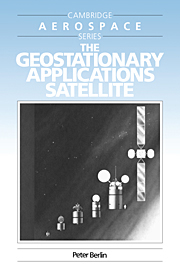Book contents
- Frontmatter
- Contents
- Dedication
- Preface
- List of Acronyms
- 1 Launch vehicles
- 2 The transfer orbit
- 3 The geostationary orbit
- 4 The satellite environment
- 5 Structures
- 6 Mechanisms
- 7 Thermal control
- 8 Power supply and conditioning
- 9 Propulsion and orbit control
- 10 Attitude stabilization, measurement and control
- 11 Telemetry, tracking and command (TT&C)
- 12 Communications payload
- 13 Meteorological payload
- 14 Product assurance
- 15 Spacecraft development and testing
- Index
10 - Attitude stabilization, measurement and control
Published online by Cambridge University Press: 02 February 2010
- Frontmatter
- Contents
- Dedication
- Preface
- List of Acronyms
- 1 Launch vehicles
- 2 The transfer orbit
- 3 The geostationary orbit
- 4 The satellite environment
- 5 Structures
- 6 Mechanisms
- 7 Thermal control
- 8 Power supply and conditioning
- 9 Propulsion and orbit control
- 10 Attitude stabilization, measurement and control
- 11 Telemetry, tracking and command (TT&C)
- 12 Communications payload
- 13 Meteorological payload
- 14 Product assurance
- 15 Spacecraft development and testing
- Index
Summary
Introduction
A geostationary applications satellite must be orientated in space such that its antennae or radiometers view the earth continuously. The solar arrays should also face the general direction of the sun at all times. Given that the satellite-earth and the satellite-sun vectors move 360° relative to each other every day, the satellite has to be something of a contortionist to satisfy both pointing conditions.
The obvious design solution to the variable two-way pointing problem is to mount the antennae or telescopes on one part of the spacecraft and the solar arrays on another, allowing the two parts to rotate in opposite directions around a common shaft. Two-way pointing can be maintained as long as the orientation or attitude of the shaft remains approximately perpendicular to the earth and sun vectors. Hence the dual spin and the three-axis stabilized design concepts (Figs 10.1–10.4).
The attitude of a spacecraft is the orientation of its body axes in inertial space. The angles which define an attitude may be direction cosines or azimuth and elevation (Fig. 10.5); the latter convention was used in Chapter 2 to derive an expression for sun angle.
Although space is virtually void of matter, it is nevertheless full of forces acting on the spacecraft (see Chapter 4), and some of these cause the attitude to drift. If the two-way pointing requirement is to be met at all times, it is necessary to ensure attitude stabilization continuously, and perform measurement and control at regular intervals.
- Type
- Chapter
- Information
- The Geostationary Applications Satellite , pp. 121 - 148Publisher: Cambridge University PressPrint publication year: 1988



